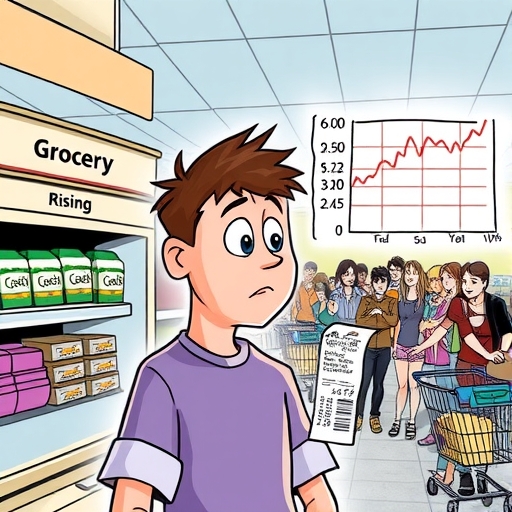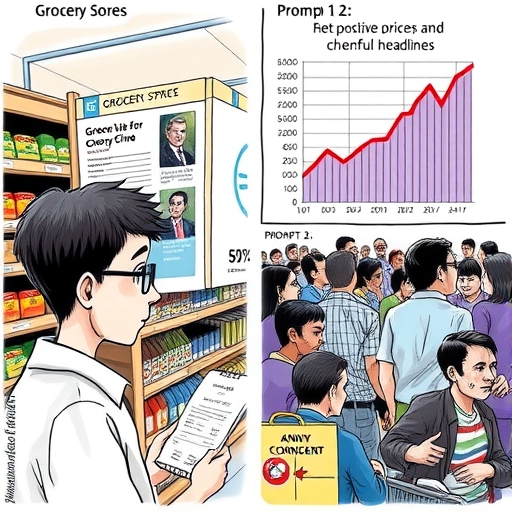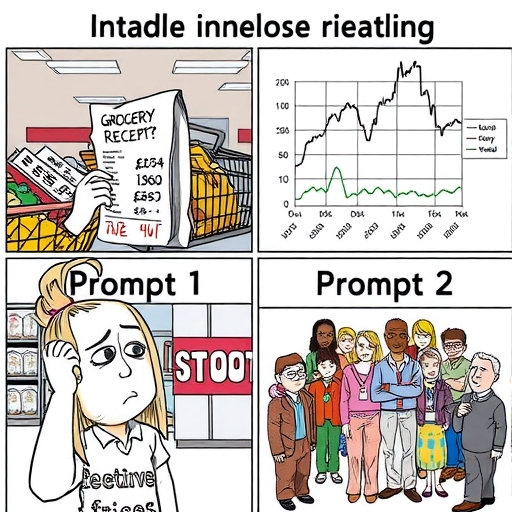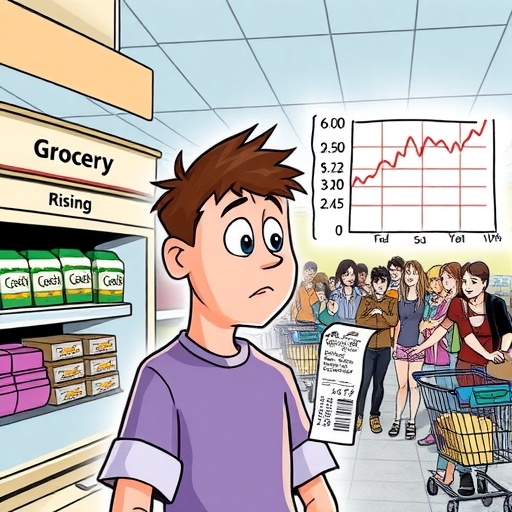Understanding the Vibecession: The Disconnect Between Economic Data and Public Feeling
Have you ever felt like the official economic reports you hear on the news don’t quite align with your own financial reality? Perhaps you see headlines about low unemployment or slowing inflation, yet when you go to the grocery store or pay your rent, things feel undeniably expensive. This isn’t just you; it’s a widespread phenomenon that economists and commentators have started calling the “vibecession.”
It’s a term that has gained significant traction in recent years, particularly in the United States, to describe a peculiar state where traditional economic data looks relatively strong, but the general public perception or “vibe” about the economy remains overwhelmingly negative or pessimistic. As investors and individuals trying to navigate complex financial landscapes, understanding this disconnect is crucial. Why do the numbers tell one story while people’s lived experiences seem to tell another? What are the underlying factors driving this sentiment, and what does it mean for our financial decisions?
In this comprehensive guide, we’ll delve deep into the meaning of the vibecession. We’ll explore its origins, examine the specific data points that seem to clash with public feeling, uncover the reasons behind this divergence, discuss its political and investment implications, and consider how it might evolve in the future. Think of us as your guide through this counterintuitive economic environment, breaking down complex ideas into understandable concepts, helping you build a clearer picture of what’s really happening beyond the headlines.

The term “vibecession” itself is a relatively recent invention, a neologism born out of the observation of this economic paradox. Coined by analyst and content creator Kyla Scanlon in June 2022, it’s a clever portmanteau combining “vibes” – referring to prevailing public sentiment or mood – and “recession.” A traditional recession is typically defined by objective economic criteria, such as a significant decline in economic activity spread across the economy, lasting more than a few months, normally visible in real GDP, real income, employment, industrial production, and wholesale-retail sales. The National Bureau of Economic Research (NBER) is the official arbiter of US recessions, relying on a committee of economists to make the determination based on a range of indicators.
A vibecession, however, isn’t a formal economic state recognized by bodies like the NBER. Instead, it captures the *feeling* of a recession, even when key economic metrics don’t support that conclusion. It’s the gap between the statistical reality (“hard data”) and the felt experience (“soft data” or sentiment). Imagine looking at a chart showing GDP growth, low unemployment rates, and inflation falling from its peak, and then talking to people who feel financially strained, insecure about their jobs, and pessimistic about the future. That gap is the vibecession.
This concept highlights an important truth: how people *feel* about the economy is not always a direct, linear reflection of aggregated statistical data. Numerous factors influence public mood, from personal financial situations and daily expenses to media narratives and psychological biases. The vibecession argues that these non-statistical factors have, in recent times, heavily outweighed the seemingly positive signals from traditional economic indicators in shaping the collective sentiment.
The United States economy in 2022, 2023, and stretching into early 2024 provided perhaps the most prominent example of the vibecession in action. On one hand, the “hard data” painted a picture of resilience and recovery:
- GDP Growth: The economy continued to grow, avoiding the technical definition of a recession (two consecutive quarters of negative GDP).
- Low Unemployment: The unemployment rate remained historically low, often hovering around or below 4.1%. The labor market was robust, with millions of jobs created and a relatively high quits rate, suggesting workers felt confident about finding new opportunities.
- Slowing Inflation: While inflation peaked at multi-decade highs, the *rate* of inflation significantly decreased throughout 2023 and early 2024, moving closer to the Federal Reserve’s target. Disinflation was evident in many sectors.
- Rising Wages: For a period, wage growth outpaced inflation, offering some relief to workers’ purchasing power, especially for lower-income earners.
- Stock Market Performance: The stock market, particularly indices like the S&P 500, reached new record highs in late 2023 and early 2024, signaling investor confidence in corporate profitability and future growth.

Yet, juxtaposed against this seemingly positive backdrop was overwhelmingly negative “soft data” and public perception:
- Pervasive Pessimism: Numerous opinion polls consistently showed that a large percentage of Americans held a negative view of the overall economy. Many believed the country was already in a recession, even if the official data didn’t confirm it.
- Financial Strain: A significant portion of the population reported feeling financially worse off than the previous year. While average wages rose, the cumulative effect of past high inflation meant the overall cost of living had increased substantially.
- Low Consumer Sentiment: Major consumer confidence surveys, like those from the Conference Board or the University of Michigan, plunged to levels typically seen during severe recessions, such as the Great Recession. This suggested people were hesitant to spend and felt insecure about their personal financial futures.
This stark contrast is the heart of the vibecession. The aggregated national statistics presented a picture of health and growth, yet individual experiences and collective sentiment surveys revealed widespread anxiety and dissatisfaction. It felt like two different economies were coexisting – the one measured by economists and the one lived by average citizens.
Understanding this disconnect requires looking beyond the headline numbers and considering the factors that shape individual financial reality and public mood. Several key elements contribute to the vibecession’s peculiar nature:
Firstly, and perhaps most significantly, is the issue of persistent high prices and the cost of living. While the *rate* of inflation slowed considerably from its peak, meaning prices weren’t rising as *fast* anymore, this did not mean prices were *falling*. The overall price level remained substantially higher than it was before the recent inflationary surge. For example, if a basket of goods cost $100 in 2019, and inflation drove it to $120 by 2022, disinflation might mean it only rises to $123 by 2024 instead of $126. While the *increase* is smaller ($3 vs. $6), the *total cost* is still $123, a 23% jump from the pre-inflationary period. This cumulative price increase, particularly in essential areas like housing, energy, and groceries, created significant and lasting financial strain for many households.

Think of it this way: receiving a pay raise feels good, but if that raise doesn’t fully compensate for the higher cost of rent, gas, and food that accumulated over several years, you still feel poorer relative to your previous spending power. This lingering effect of elevated price *levels*, even with slowing inflation, is a major driver of negative sentiment.
Secondly, certain sectors disproportionately impact public feeling. While the overall housing market might see national price trends, local rent increases or high mortgage rates can severely impact affordability for individuals, fueling anxiety. Energy prices, visible every time someone fills their car, are highly salient indicators of economic health for many people, even if they represent a small portion of the overall economy.
It’s not just objective financial facts that shape our view of the economy; how we process information and the information we are exposed to play a huge role. This leads us to other significant contributors to the vibecession:
The news media environment often contributes to the negativity. Negative news tends to be more attention-grabbing than positive news. Economic reporting can sometimes focus heavily on risks, potential downturns, or anecdotes of hardship, even when aggregate data is positive. Headlines might emphasize high prices or potential layoffs more prominently than low unemployment figures or wage gains. This constant exposure to pessimistic framing can significantly influence public mood, regardless of the underlying statistics.
Furthermore, human beings have an inherent negativity bias. We tend to pay more attention to, remember, and be more influenced by negative experiences or information than positive ones. This psychological quirk means that even if many things are going well economically, a few points of pain – like the high price of gas or a worrying article about recession risks – can dominate our overall perception and outweigh numerous positive data points.
There’s also the phenomenon of expectation setting. After predictions of a recession were widespread throughout 2023, the fact that one didn’t materialize as expected might have led to a feeling of economic stagnation or disappointment for some, rather than relief, especially if their personal situation didn’t improve significantly. The narrative of impending doom, even if unfulfilled by data, can leave a lasting impression on sentiment.
Another crucial element of the vibecession is the inherent limitation of using aggregated national statistics to reflect individual experiences. While metrics like GDP and national unemployment rates are valuable for macro-level analysis, they don’t always capture the nuances of financial life for every citizen.
Think of the national unemployment rate as an average temperature across a country. A comfortable average of 70°F doesn’t tell you if it’s snowing in one region and 100°F in another. Similarly, a low national unemployment rate doesn’t mean everyone who wants a job has one, or that the jobs available pay enough to cover the cost of living in expensive areas. It doesn’t distinguish between full-time, well-paying jobs and part-time, precarious work. Wage growth numbers, while positive on average, might mask stagnation or decline for specific demographics or industries.
Aggregate data provides a high-level view, but it can smooth over the very real struggles faced by individuals or specific communities. If your rent increased by 30% over two years, and your wages only went up by 10%, national statistics showing 4% unemployment and 3% inflation (year-over-year) feel irrelevant to your personal financial strain. The vibecession highlights the gap between the statistical picture of the economy and the felt reality of personal finances.
Given that economic sentiment is a powerful driver of voter behavior, the vibecession has significant political implications. In the US context, the period of vibecession largely coincided with President Joe Biden’s term. Despite presiding over an economy with low unemployment, cooling inflation, and GDP growth, his approval ratings on the economy remained persistently low. Polls showed many Americans, including those who reported being financially stable themselves, rating the national economy negatively.
This underscores a challenge for policymakers: how do you get credit for positive economic outcomes when the public *feels* like things are bad? It highlights the power of perception and sentiment, sometimes overriding the factual data. Politicians might be tempted to either lean into the negative sentiment (as opposition parties often do) or try to persuade the public that the data is correct and their feelings are misplaced – a strategy that can sometimes be perceived as gaslighting, further eroding trust.
Understanding the vibecession is vital for political strategists. It suggests that winning public support on economic issues isn’t just about presenting favorable statistics; it’s about addressing the factors that drive sentiment, such as the felt impact of high prices, job security anxieties, and overall financial well-being. Future elections may well be decided not by GDP growth charts, but by how people *feel* about their ability to afford their lives.
Predicting the future of the economy is always challenging, but several factors could influence whether the vibecession persists, resolves, or potentially gives way to a more traditional economic shift, like a real recession. One key area to watch is **future policy decisions.** For instance, discussions around potential high **tariffs** on imported goods, as proposed by some political figures, could reverse some of the progress made on disinflation by increasing the cost of goods for consumers and businesses. Such policies could exacerbate the feeling of high prices or even contribute to renewed inflationary pressures, potentially prolonging the vibecession sentiment or creating new economic headwinds.
Furthermore, while the labor market has been robust, some indicators suggest potential future softening. Weakening **profit margins** for companies, particularly if input costs continue to rise faster than companies can increase prices (a phenomenon known as declining pricing power), could eventually force businesses to cut costs, including through layoffs. A significant increase in initial jobless claims or a sustained rise in the unemployment rate could finally bring the “hard” labor market data more in line with negative consumer anxieties about job security.
Conversely, factors that could alleviate the vibecession include a continued period of moderate wage growth combined with stable or slightly falling prices for essential goods, which would genuinely improve people’s purchasing power and chip away at the cumulative effect of past inflation. A sustained period of economic stability where the positive data *persists* might also, over time, begin to shift public sentiment, gradually building confidence.
However, some experts suggest the disconnect between data and feeling might be a more enduring feature of the modern information age, influenced by constant streams of information and psychological biases. The future of the vibecession remains an open question, subject to economic trends, policy choices, and the complex dynamics of public psychology.
For investors and traders, the vibecession presents a unique environment. Market movements are often driven by both fundamental economic data and investor sentiment. During a vibecession, sentiment is gloomy, even when the fundamental economic data (like corporate earnings, GDP growth, or employment) appears relatively strong. This divergence can create challenges, as negative public mood might weigh on market valuations, but it can also potentially present opportunities for savvy investors looking beyond the prevailing pessimism.
A key challenge is distinguishing between a genuine economic slowdown signaled by hard data and a sentiment-driven funk. During a vibecession, “soft data” like consumer confidence surveys might flash recessionary warnings, while “hard data” like industrial production or employment holds up. Investors need to carefully analyze which signals are currently more influential and what they truly indicate.
The pervasive pessimism can sometimes lead to undervalued assets if the market is pricing in a downturn that the fundamental data doesn’t yet support. Conversely, if the “soft data” deterioration is a *leading indicator* of future “hard data” weakness (as some historical periods suggest can happen), then the pessimism might be a warning sign that investors should heed.
Given the complex backdrop of a vibecession – strong official data mixed with genuine cost-of-living pressures and negative sentiment – what investment approaches might be worth considering? While this is not financial advice specific to your situation, certain strategies tend to fare better during times of economic uncertainty, regardless of whether it’s a data-driven recession or a sentiment-driven vibecession.
- Focus on Quality: Companies with strong balance sheets, consistent profitability, durable business models, and pricing power are often more resilient in challenging environments. They are better equipped to navigate potential pressures on profit margins and less reliant on overall economic booms for survival. Look for companies that can maintain earnings even if consumer spending tightens due to the perception of a weak economy.
- Dividend Growers: Companies that consistently grow their dividends can provide a source of income and often signal financial health and a commitment to returning value to shareholders. While they might not offer explosive growth, they can provide stability and compounding returns over time.
- Assess Valuation Carefully: Negative sentiment can sometimes depress stock prices below their intrinsic value based on fundamentals. This requires careful analysis to distinguish between genuinely struggling companies and fundamentally sound companies that are simply caught in a wave of pessimism. Avoid “value traps” – stocks that look cheap but have fundamental, irreversible problems.
- Consider Defensive Sectors: Sectors like consumer staples, healthcare, and utilities tend to be less cyclical than others, as demand for their products and services remains relatively stable even when the economy feels weak.
- Diversification: Maintaining a diversified portfolio across different asset classes (stocks, bonds, potentially commodities or real estate) and geographies can help mitigate risk during periods of uncertainty.
Beyond simply identifying potential opportunities across various assets, successful trading requires efficient execution and reliable technology. When choosing a trading platform, the flexibility and technological advantages of Moneta Markets are noteworthy. Supporting mainstream platforms like MT4, MT5, and Pro Trader, combined with high-speed execution and low spread settings, it offers a good trading experience.
Historical Parallels: Has This Feeling-Data Disconnect Happened Before?
While the term “vibecession” is new, the concept of public sentiment diverging from official statistics is not entirely unprecedented. Looking back at history, we can find periods where similar dynamics were at play, albeit driven by different circumstances.
One notable example sometimes cited is the mid-1970s. The US economy was grappling with the fallout from the 1973 oil embargo, leading to high inflation and economic stagnation. While official data eventually caught up with a recession (1973-1975), consumer sentiment deteriorated sharply *before* some of the hardest economic data fully reflected the depth of the downturn. The feeling of being hit by soaring energy prices and general uncertainty about the future led to a negative public mood that arguably preceded and amplified the official recessionary signals.
Another, though different, comparison can be made to periods following significant economic shocks or bubbles, where public trust in economic institutions or official pronouncements remains low for an extended period, even after some recovery has occurred. The memory of financial pain (like the Great Recession of 2008) can linger and make people more skeptical of positive economic news, anchoring their sentiment in past hardship rather than current data.
These historical parallels remind us that economic reality is a complex interplay of quantifiable data, psychological factors, and external events. The vibecession is perhaps a modern manifestation of this enduring tension, amplified by the speed and nature of information flow in the digital age.
Conclusion: Understanding the Vibecession’s Complex Tapestry
The vibecession is more than just an interesting buzzword; it’s a powerful illustration of the multifaceted nature of economic well-being. It highlights that a healthy economy isn’t solely defined by GDP growth or unemployment percentages. It’s also about how people *feel* – about their ability to afford their lives, their job security, and their confidence in the future.
In recent years, the stark contrast between robust hard data and pessimistic soft data has been a defining characteristic of the economic landscape, particularly in the United States. This disconnect is fueled by the lasting impact of high price levels (even with slowing inflation), influenced by media narratives and inherent psychological biases, and underscores the limitations of relying solely on aggregate statistics to capture the full economic picture experienced by individuals.
For policymakers, the vibecession is a reminder that communication and addressing the felt reality of citizens are as crucial as managing the economic fundamentals. For investors, it presents a challenge to look beyond prevailing sentiment and carefully analyze both hard and soft data, seeking resilient opportunities amidst the uncertainty. As we move forward, how this gap between feeling and fact evolves will be a critical watchpoint for everyone trying to understand the true state of the economy.
By understanding the nuances of the vibecession, you gain a deeper appreciation for the human element in economics – recognizing that statistics tell only part of the story and that perception, driven by lived experience and external factors, plays a vital role in shaping our collective economic reality.
| Indicator | 2022 | 2023 | 2024 (Projected) |
|---|---|---|---|
| GDP Growth | 2.5% | 3.1% | 2.3% |
| Unemployment Rate | 4.0% | 3.9% | 4.1% |
| Inflation Rate | 8.0% | 4.5% | 2.0% |
| Average Wage Growth | 3.0% | 5.0% | 4.0% |
| Factor | Impact on Sentiment | Example |
|---|---|---|
| High Prices | Negative | Rising grocery costs |
| Media Coverage | Negative | Focus on potential layoffs |
| Psychological Bias | Negative | Focusing on negative news |
| Local Economic Issues | Negative | High local rent increases |
| Strategy | Description |
|---|---|
| Focus on Quality | Invest in companies with strong fundamentals. |
| Dividend Growers | Seek companies with a history of consistent dividend increases. |
| Assess Valuation | Look for undervalued stocks with strong fundamentals. |
| Consider Defensive Sectors | Invest in sectors that remain stable during downturns. |
| Diversification | Spread investments across various asset classes. |
vibecession meaningFAQ
Q:What is a vibecession?
A:A vibecession describes a disconnect between strong economic data and negative public sentiment about the economy.
Q:Who coined the term vibecession?
A:The term was coined by Kyla Scanlon in June 2022.
Q:What are the main factors contributing to vibecession?
A:High prices, media coverage bias, and psychological factors are key contributors.
